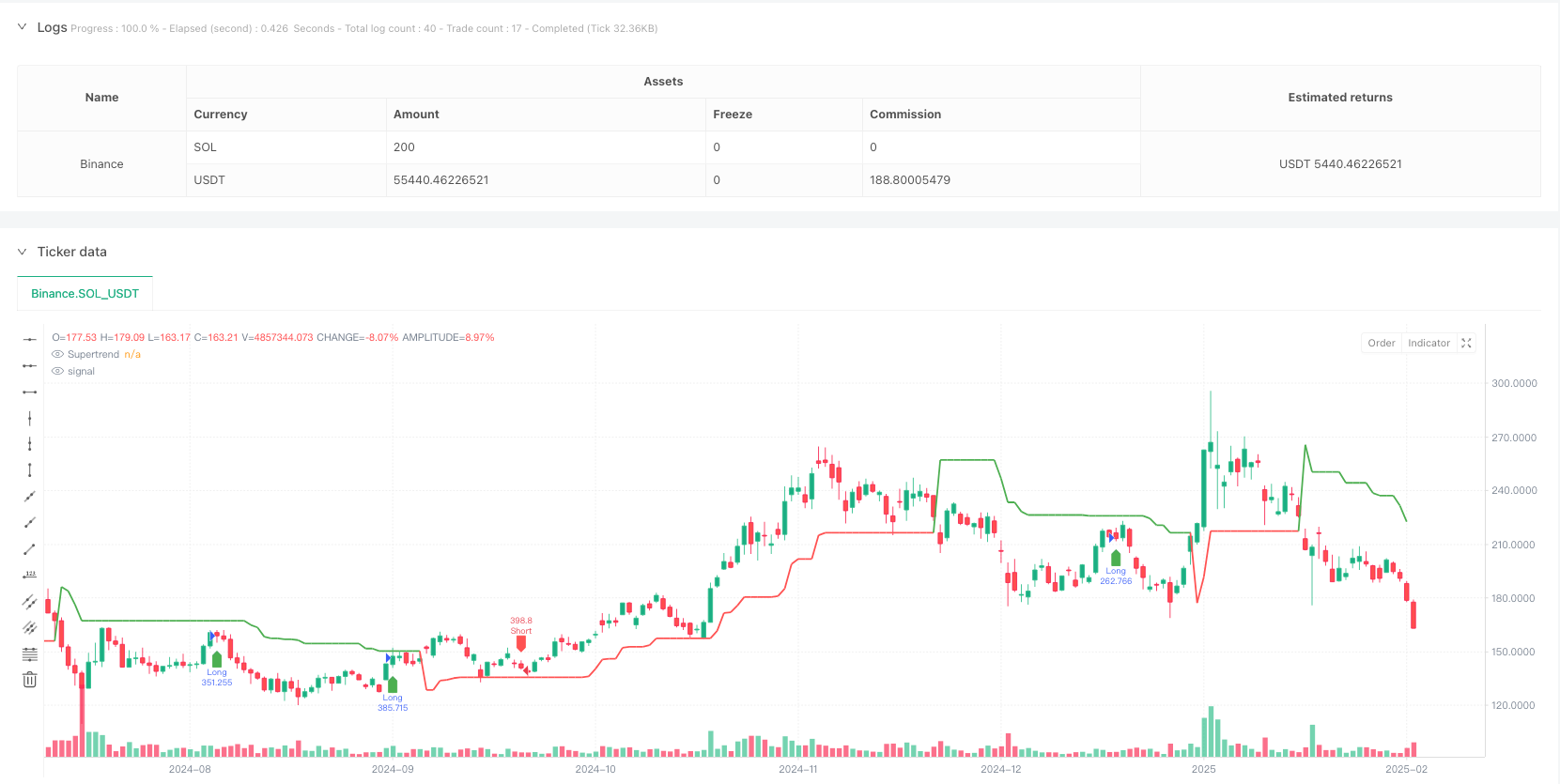

概述
该策略是一个融合了多个技术指标的自适应趋势跟踪交易系统。它结合了均线系统(EMA)、动量指标(RSI)、趋势指标(MACD)和SuperTrend进行信号确认,并配备了完善的风险管理机制,包括止损、止盈和移动止损等功能。策略设计充分考虑了市场波动性,通过多重信号过滤和风险控制来提高交易的稳定性和可靠性。
策略原理
策略采用多层信号确认机制: 1. 通过9周期和21周期EMA的交叉确定初步趋势方向 2. 使用RSI(14)进行超买超卖过滤,买入信号要求RSI>40且<70,卖出信号要求RSI<60且>30 3. MACD指标验证趋势动能,要求信号线与MACD线方向一致 4. SuperTrend指标提供额外的趋势确认 5. 风险控制采用5%止损、10%止盈、2%追踪止损和1%保本点位 当所有条件同时满足时才会触发交易信号,有效降低了假突破带来的风险。
策略优势
- 多重信号确认机制显著降低假信号干扰
- 完善的风险控制体系,包含固定止损、移动止损和保本止损
- 策略具有良好的自适应性,可以适应不同的市场环境
- 入场和出场逻辑清晰,易于理解和维护
- 交易逻辑具有良好的理论基础,每个指标都有其特定的功能
策略风险
- 多重信号确认可能导致错过一些重要的交易机会
- 在剧烈波动市场中,固定的止损位可能不够灵活
- 参数优化可能导致过度拟合历史数据
- 多个指标可能在横盘市场产生混淆信号 解决方案包括:动态调整止损参数、引入波动率指标、定期重新优化参数等。
策略优化方向
- 引入自适应参数机制,根据市场波动率动态调整各项参数
- 增加成交量指标作为辅助确认工具
- 优化止损机制,引入基于ATR的动态止损
- 加入市场环境识别模块,在不同市场条件下使用不同的参数组合
- 开发基于机器学习的参数优化系统
总结
该策略通过多维度技术指标的协同配合,构建了一个稳健的交易系统。完善的风险控制机制和清晰的交易逻辑使其具有良好的实用性。虽然存在一定的优化空间,但策略的基本框架具有扎实的理论基础,通过持续优化和改进,有望进一步提升其交易效果。
策略源码
/*backtest
start: 2024-02-22 00:00:00
end: 2025-02-19 08:00:00
period: 1d
basePeriod: 1d
exchanges: [{"eid":"Binance","currency":"SOL_USDT"}]
*/
//@version=5
strategy("Optimized BTC Trading Strategy v2", overlay=true, default_qty_type=strategy.percent_of_equity, default_qty_value=100, commission_type=strategy.commission.percent, commission_value=0.1)
// Input parameters
emaShort = ta.ema(close, 9)
emaLong = ta.ema(close, 21)
// RSI settings
rsi = ta.rsi(close, 14)
rsiBuyLevel = 40
rsiSellLevel = 60
// MACD settings
[macdLine, signalLine, _] = ta.macd(close, 12, 26, 9)
// Supertrend settings
factor = input.float(3, title="Supertrend Factor")
atrLength = input.int(10, title="ATR Length")
[superTrend, superTrendDirection] = ta.supertrend(factor, atrLength)
// Risk Management (Stop Loss & Take Profit)
stopLossPercent = 0.05 // 5%
takeProfitPercent = 0.10 // 10%
trailingStopPercent = 0.02 // 2% trailing stop for additional security
breakevenBuffer = 0.01 // 1% breakeven buffer
// Fetching average price once to avoid repeated calculations
var float avgPrice = na
if strategy.position_size != 0
avgPrice := strategy.position_avg_price
// Stop Loss & Take Profit Levels
longSL = avgPrice * (1 - stopLossPercent)
longTP = avgPrice * (1 + takeProfitPercent)
shortSL = avgPrice * (1 + stopLossPercent)
shortTP = avgPrice * (1 - takeProfitPercent)
breakevenLevel = avgPrice * (1 + breakevenBuffer)
// Entry Conditions
buyCondition = ta.crossover(emaShort, emaLong) and rsi > rsiBuyLevel and rsi < 70 and (macdLine > signalLine) and superTrendDirection == 1
sellCondition = ta.crossunder(emaShort, emaLong) and rsi < rsiSellLevel and rsi > 30 and (macdLine < signalLine) and superTrendDirection == -1
// Ensure no conflicting trades
if buyCondition and strategy.position_size <= 0
strategy.entry("Long", strategy.long)
strategy.exit("Long Exit", from_entry="Long", limit=longTP, stop=longSL, trail_points=trailingStopPercent * avgPrice)
strategy.exit("Breakeven", from_entry="Long", stop=breakevenLevel)
if sellCondition and strategy.position_size >= 0
strategy.close("Long")
strategy.entry("Short", strategy.short)
strategy.exit("Short Exit", from_entry="Short", limit=shortTP, stop=shortSL, trail_points=trailingStopPercent * avgPrice)
strategy.exit("Breakeven", from_entry="Short", stop=breakevenLevel)
// Plot Buy & Sell signals with trend-based color indicators
plotshape(series=buyCondition, location=location.belowbar, color=color.green, style=shape.labelup, title="BUY", size=size.small)
plotshape(series=sellCondition, location=location.abovebar, color=color.red, style=shape.labeldown, title="SELL", size=size.small)
// Trend Indicator (for better visualization)
plot(superTrend, color=superTrendDirection == 1 ? color.green : color.red, linewidth=2, title="Supertrend")
相关推荐